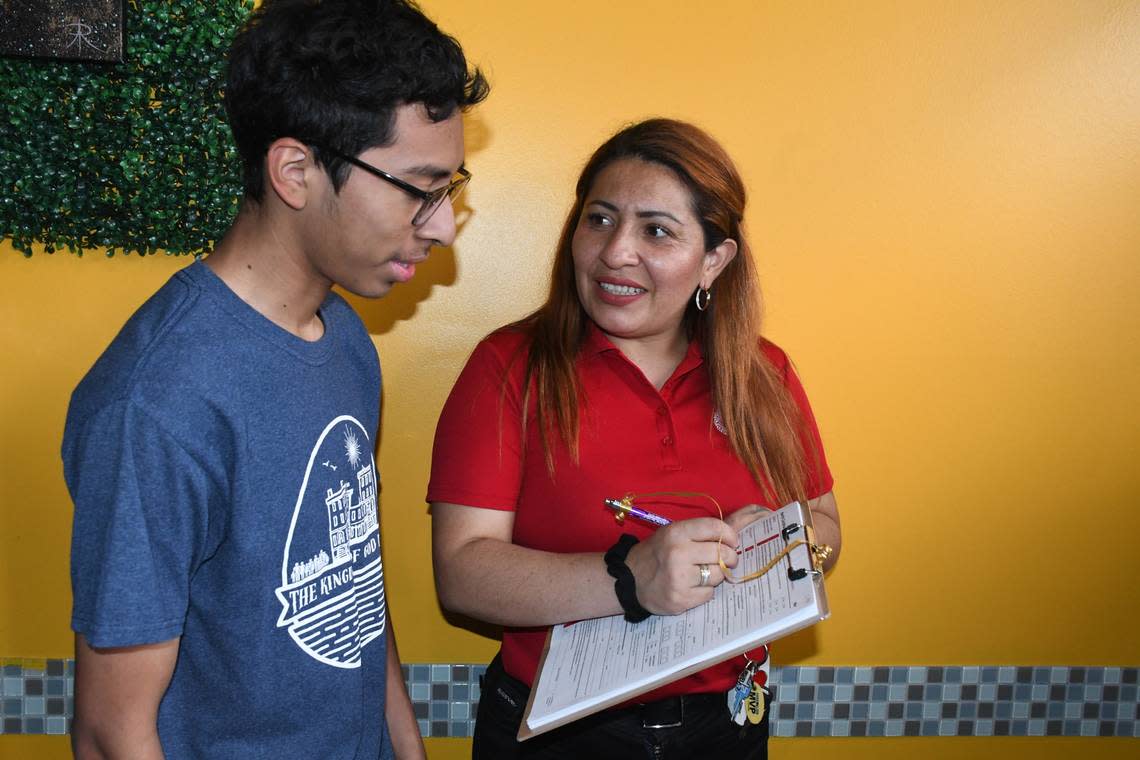In 6 charts and a map, a look at NC Latino voter registration, turnout and party preference
Latino North Carolinians who can vote — that is, those who are U.S. citizens of voting age — more than doubled in just 12 years.
And while the state’s Latino voters have tended to favor Democrats, there are signs that Republicans could be gaining ground.
Here’s a look at population growth, voting trends and more for the Latino population in North Carolina.
Growing voting population
The fastest-growing population in the state since the 1990s, according to the state demographer’s office, the Latino population in North Carolina grew about 45% from 725,000 in 2010 to 1.1 million in 2022. They now make up about 11% of the state’s population.
Of those Latinos, about a third are over 18 and eligible to vote. And more are becoming eligible every year. Between 2010 and 2022, the number of citizen, voting-age Latino residents in the state has grown 142% from 160,000 to 388,000, according to Nathan Dollar, director of Carolina Demography, the demography unit of the Carolina Population Center at UNC-Chapel Hill.
And as of late July, over 4% of North Carolina registered voters identified as Hispanic, a total of more than 300,000 people.
Latinos are spread out across the state, with some swaths of voters converging in the Charlotte and Raleigh areas. This dispersion can make targeting these voters harder. Also making it harder can be language barriers, as for many Latinos, English is not their first language. Latino voters also tend to be younger than the general population, meaning many are either newly eligible to vote in the 2024 elections or set to become eligible to vote in future elections.
Census data shows that the median age in North Carolina is 39, but for those who identify as Hispanic or Latino, the median age is 25.
Latino turnout
While the voting population has grown, turnout runs low: Of Latinos eligible to register and vote, only 36% registered to vote, and of those, only 25% cast a ballot in the state’s 2022 midterm elections. In comparison, across all races and ethnicities there was a 51% voter turnout.
During the presidential election in 2020, nearly 59% of registered Latino voters turned out. Across all races and ethnicities, more than 75% of eligible voters in NC turned out to vote that year.
This low turnout often means Latino voters are sidelined during political campaigns and “not listened to,” said Frederick Velez, senior director of communications at the Hispanic Federation, one of the nation’s largest Latino advocacy organizations.
Party preference
Latino voters are registered with the Democratic Party more than other voters, but they are less tied to parties overall, with almost half identifying as unaffiliated.
As of late July, just over 36% of Latinos were registered as Democrats, just under 16% as Republicans and just over 46% as unaffiliated.
In comparison, of non-Hispanic voters, almost 34% were registered as Democrats, just over 32% as Republicans and just over 33% as unaffiliated.
Across the years, North Carolinians have been registering more and more as unaffiliated, with that becoming the most popular party designation in the state in 2022.
That is true for Hispanic voters as well. As recently as 2016, Democrats outnumbered the unaffiliated among registered Hispanic voters, but that’s now flipped.
Registered Democrats are typically the biggest group of Latino voters participating in elections.
But during the most recent statewide election — the March primary — that was not the case. About 33% of Latino voters who turned out to vote were registered with the Democratic Party, while just under 29% were registered with the Republican Party. The greatest share, over 37%, were registered as unaffiliated.
Latinos also opted to vote in the Republican primary much more than in past years. Almost as many Latino voters chose the GOP ballot as chose the Democratic one.
This could be due in part to the Democratic presidential primary featuring President Joe Biden as the sole option on the ballot while the Republican ballot listed former President Donald Trump, Florida Gov. Ron DeSantis, former South Carolina Gov. Nikki Haley and others.
During state primary elections voters pick which candidates from one party, from across various partisan offices, they would like to see move on to the general election.
During presidential election years, voters also select their preferred presidential nominee. North Carolina has a semi-open primary, meaning voters registered with a specific party can participate solely in that party’s primary. Meanwhile, unaffiliated voters can elect which party primary they would like to participate in.
Latino unaffiliated voters
In terms of what primary unaffiliated Latino voters opt to participate in, there was a switch this year.
Since 2012, Latino unaffiliated voter participation in Democratic primaries had been steadily increasing, while Republican primary participation had been decreasing. But in 2024, more Latino unaffiliated voters participated in the Republican primary than in the Democratic primary.
The more competitive GOP presidential primary could again play a role.
And there’s one more factor to consider, said Michael Bitzer, a politics professor at Catawba College.
“Certainly, Republicans could be making inroads,” Bitzer said. But it may also be that these voters tend to live in “lopsided political areas,” where they “realize the only way to influence an election is the primary election to pick the candidate who’s ultimately going to win in November.”
“If you’re living in a predominantly Republican county, for example, like Rowan County, it’s hard to nearly impossible for a Democrat to win countywide in this county, it’s so Republican. So a lot of, particularly unaffiliated voters, the only election that they can have a true impact on is going to be in the primary election.”
North Carolina’s rural areas tend to run deeply red, while urban areas are a heavy blue.
Some areas are still purple (or a tossup), such as Scotland County, which flipped from blue to red in 2020. Obama won the county by a wide margin in both 2008 and 2012. Hillary Clinton won in 2016 with 52.5% of the vote. But in 2020, Trump won with 50.58%.
Under the Dome
Get the latest news about North Carolina politics from The News & Observer's award-winning team. Get the free digest sent to your inbox by signing up here.









